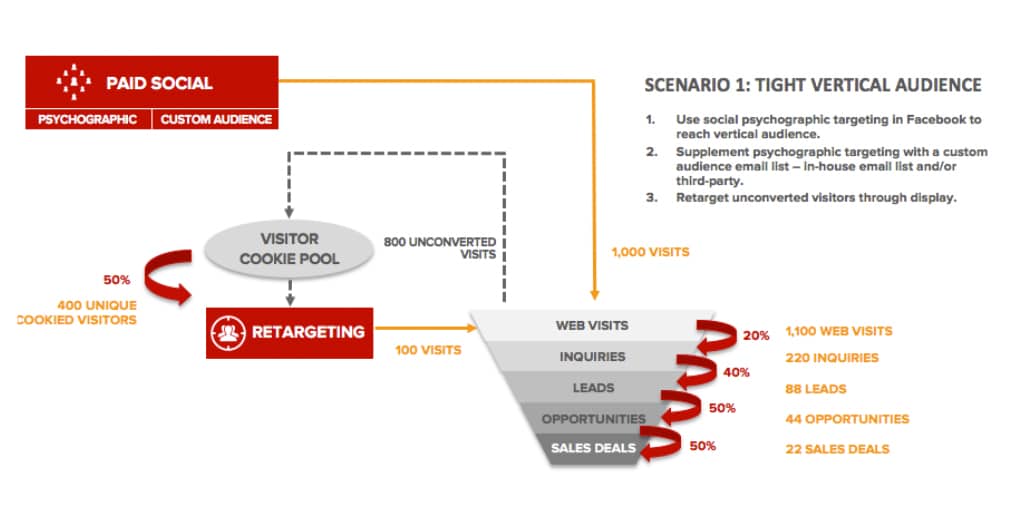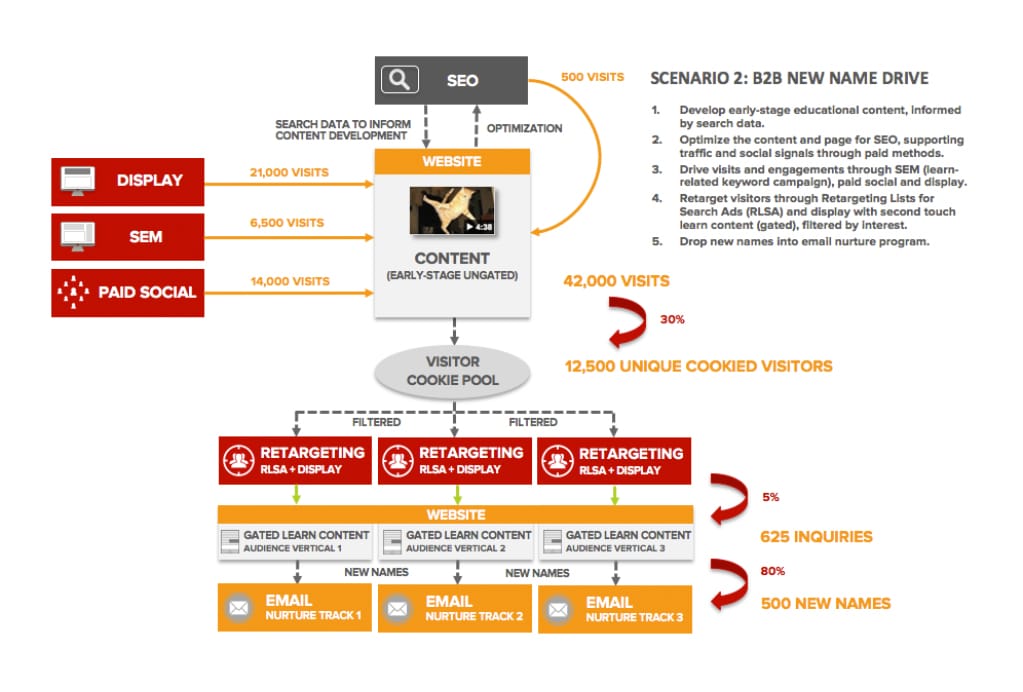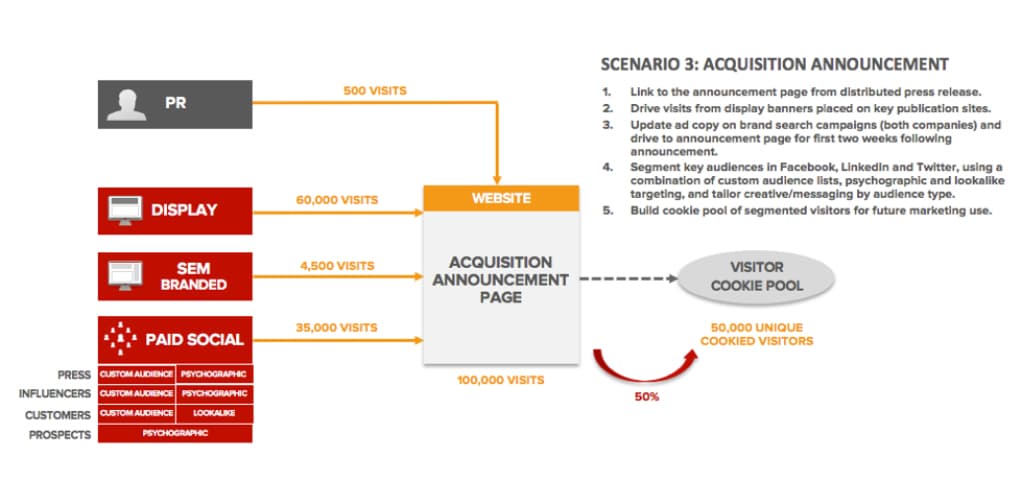Integrated marketing. That old chestnut. You’ve heard it countless times over the years, but what does it really mean, anyway? And is there anyone out there who does integrated marketing well?

In the 15 years spent with in-house marketing teams, we’ve been lucky to run some lucrative integrated marketing programs. It’s always heady to pioneer integrated paid and organic search, social, display, PR and content approaches. What we’ve learned, working on both agency and client sides, is that successful integrated marketing starts with a clear understanding of goals, capabilities and pipeline, which helps to uncover the right selection of channels. Here are the spicy steps, from mild to wild, to get you there.
STEP 1: Korma – Define Your Goals
Kormas are the beginner’s curry – creamy, mild, and only slightly spiced. Setting clear goals is the beginning step for any marketing campaign, integrated or otherwise. Be honestly clear whether your primary focus is on awareness, demand generation or sales. From here, identify what your Key Performance Indicators (KPIs) are – indicators that you will use to measure campaign success. The closer you can tie your marketing programs to business revenue and Return on Investment measures, the higher your value is as a marketer (and as a department) to your organization.
Step 2: Balti – Understand Your Tracking Capabilities
The Balti is a fragrant curry with plenty of flavor depth. In an ideal world, all marketers would be able to directly connect the depth of their efforts to sales, revenue and ROI, and be able to attribute contribution from each channel – that is the holy grail! The challenge comes down to your tracking capabilities. Certain situations may influence the extent to which you can link your marketing activities to revenue.
For example, some B2B companies with long sales cycles may find it much more challenging to to tie their online marketing efforts to offline sales. While I’ve seen it done, it requires a lot more internal coordination, cooperation, standard process and human intervention, compared to a straight up e-commerce operation. Consequently, various flavors of “leads” (be it pre-qualified leads, marketing qualified leads, marketing accepted leads, etc.) often become the key measure for many organizations. While this doesn’t quite hit the revenue mark, it is still a strong scoville indicator of marketing value, and at the very least, calculations can be applied to provide some level of directional contribution towards sales.
Step 3: Madras – Calculate Your Marketing Pipeline
The Madras is where the spiciness factor starts to kick in. To eat this curry comfortably takes practice and it isn’t easy. However far within the funnel you are able to track, it is important to fill in the blanks of your marketing pipeline, because ultimately your top of funnel metrics will get you to your end KPI. Lead calculations are a good place to start, ideally by applying conversion rates based upon your own organization’s performance. It may not be easy to begin with, but by having a full funnel understanding, you can start to put things into perspective by asking questions like, “How can I drive X amount of visits with X amount of budget?” and “What is the right channel mix in order to accomplish this effectively?”.
Step 4: Vindaloo – Know Your Marketing Channels And How They Work Together
The Vindaloo is a fiery curry, not for the faint of heart. With its high spiciness factor, you need to be an accomplished curry aficionado to stomach it. Effectively utilizing the right combo of digital marketing channels will bring a whole new level of spice to your marketing approach. With a clear understanding of your goals and marketing funnel, let’s take a look at where these channels contribute. Without getting too bogged down, here’s a quick cheat sheet of your choices:
Display Ads provide you with broad reach when it comes to impressions, which in turn can lead to higher web visit volumes. However, visits from display often convert at a lower rate compared to other channels, such as search. Due to the high volume and lower conversion rate, display pairs great with retargeting, and is well complemented by paid search and paid social.
PR adds credibility through media and other third parties, though results can be difficult to attribute beyond clippings and impressions. While PR is often not thought of as a typical digital channel, it should be since it plays so well with paid social – social PR psychographic segmentation, anyone?
SEO also adds credibility, but at the point of searcher intent. Consequently, web traffic from organic search is often the highest converting of all channels, but guaranteeing Search Engine Results Page (SERP) visibility is difficult to control and predict. This is why SEO integrates well with paid search.
Paid Search / Search Engine Marketing (SEM) visibility is a lot easier to control in the SERP through media spend, and can be targeted to reach searchers at the point of intent, across all stages of the buyer’s journey (whether they are learning, buying or using), as well as by geo and device. However, companies or business units operating within vertical markets may find targeting audiences through keywords either too broad and lacking relevance, or too narrow with not enough volume to move the needle. That’s why paid search works so well with Retargeting Lists for Search Ads (RLSA), particularly for broader keyword sets, SEO and paid social media.
Paid Social Media can reach vertical audiences with laser precision through psychographic targeting that covers things like interests, attitudes, lifestyles, demographics, and more. However, without indication of intent, these prospects tend to sit earlier in the funnel and require more nurturing to become a lead or a sale. This is why paid social media pairs well with retargeting. Email lists are also great to use for custom audience targeting.
Organic Social posts these days tend to work best when it is being amplified through paid social media. Community management is also a common use – helping drive visitors either early within the buyer’s journey, or more often to nurture existing customers through support issues.
Retargeting helps us to recapture lost prospects who were not yet ready or convinced to take the next step towards a purchase. To ensure higher relevance, large retargeting lists can be further filtered by interest, with creative tailored appropriately to the different audiences. Retargeting supports display, social and search efforts very well, ensuring that no “lead” gets left behind.
Ultimately, all of these channels rely on flavorful content that spans early, mid and late stages of the buyer’s journey, even more so for businesses with complex sales cycles. Regardless if you are a B2B or e-commerce operation, a strong landing page is a must to carry visitors through to conversion or sale.
Step 5: Phaal – Go At It!
STRAP ON YOUR BIB. The eye-watering, nose-running, sweat-inducing Phaals are one million scoville units of fun pain. Now you have built up your curry immunity, you are ready to start applying. Here are a few different scenarios to see what channel combinations can be used together to drive results.
Scenario 1 (Sales): Let’s ease in with a straight forward scenario: how to reach a very specific vertical audience. In this scenario, the challenge is not so much converting visitors once they are on the site, but more-so getting the right audience to the site to begin with. Paid search methods to date have either been too broad and not reached the right set of people, or too narrow and driven next to nothing in volume. Ultimately, the KPI is to drive 22 sales deals from marketing.
Scenario 2 (Demand Generation): What about a broader audience composed of many different audience verticals? In this scenario, let’s take a B2B operation with a long five-year sales cycle, wanting to get 500 new names into their marketing database to nurture. A content audit reveals that although there is an abundance of mid- and late-stage content for nurture, there are no strong early-stage acquisition content assets available.
Scenario 3 (Awareness): In this scenario, a company wants to raise awareness of an upcoming acquisition that will expand them into complementary new markets. They want to reach press and industry influencers, as well as existing customers of the acquired company and other potential prospects. The goal is to get 100,000 visits to the announcement page and build audience cookie pools for later retargeting efforts.
Integrated marketing is not about spreading yourself across a mish-mash of different channels. Rather, it’s about having a planned approach that starts with the end goal in mind, and selecting the right combination of channels – based upon their strengths – to get you to that goal. Remember, good integrated marketing is like a good curry: colorful layers of depth where the outcome is far greater than any individual ingredient.
Want a closer look? These handy integrated marketing frameworks are free to download. Or if you are looking for a customized framework to fit your business, we’d be happy to help out.















